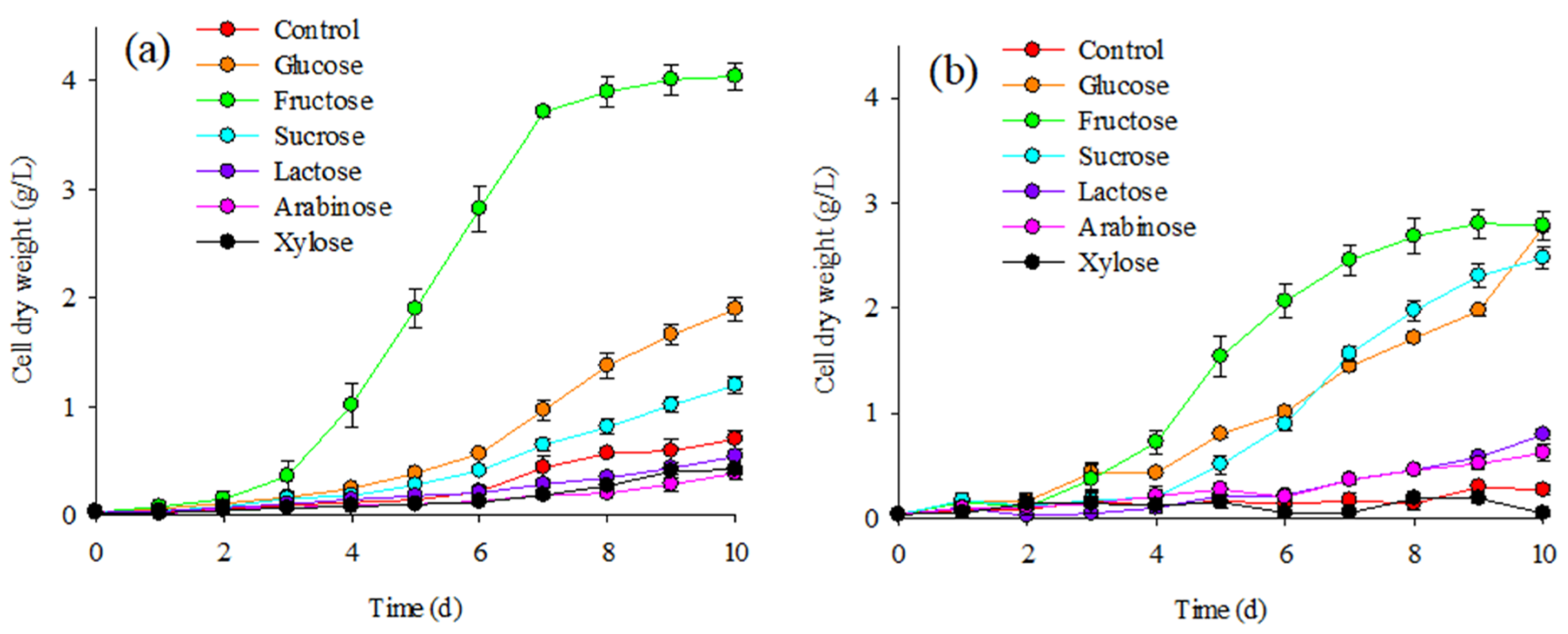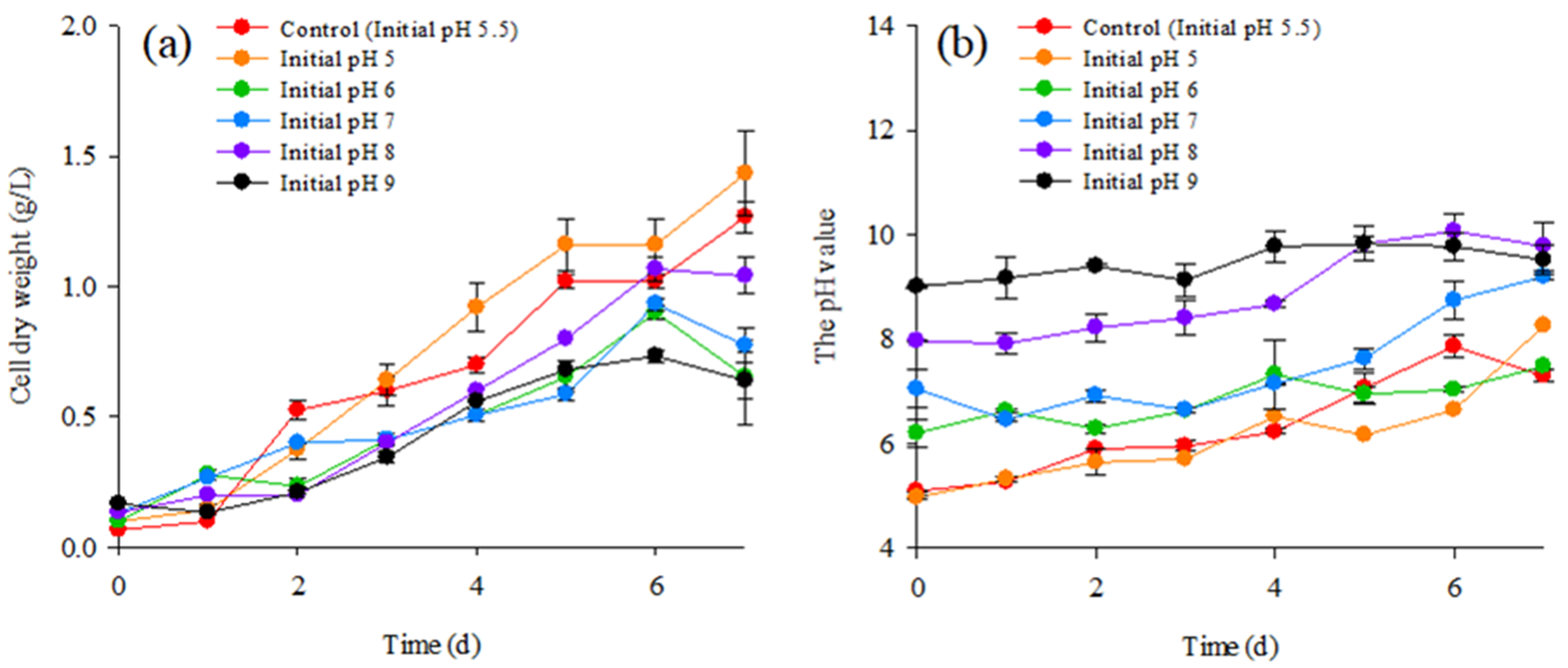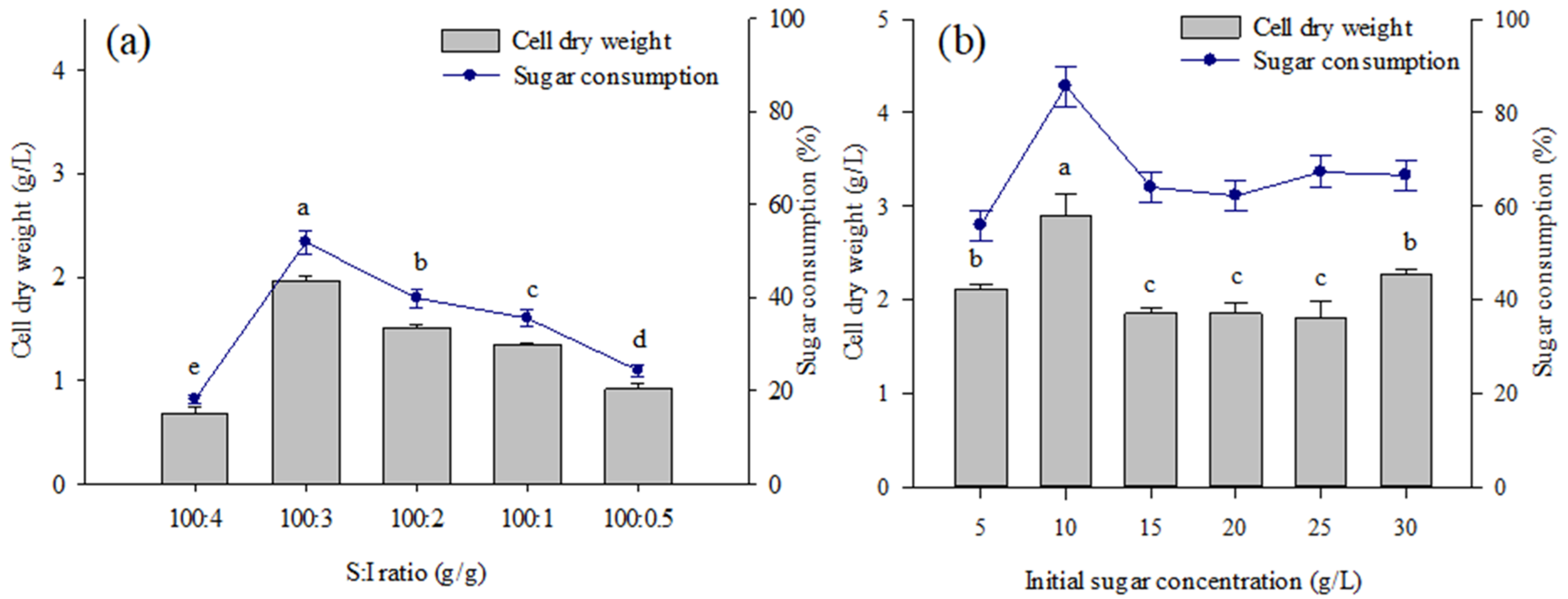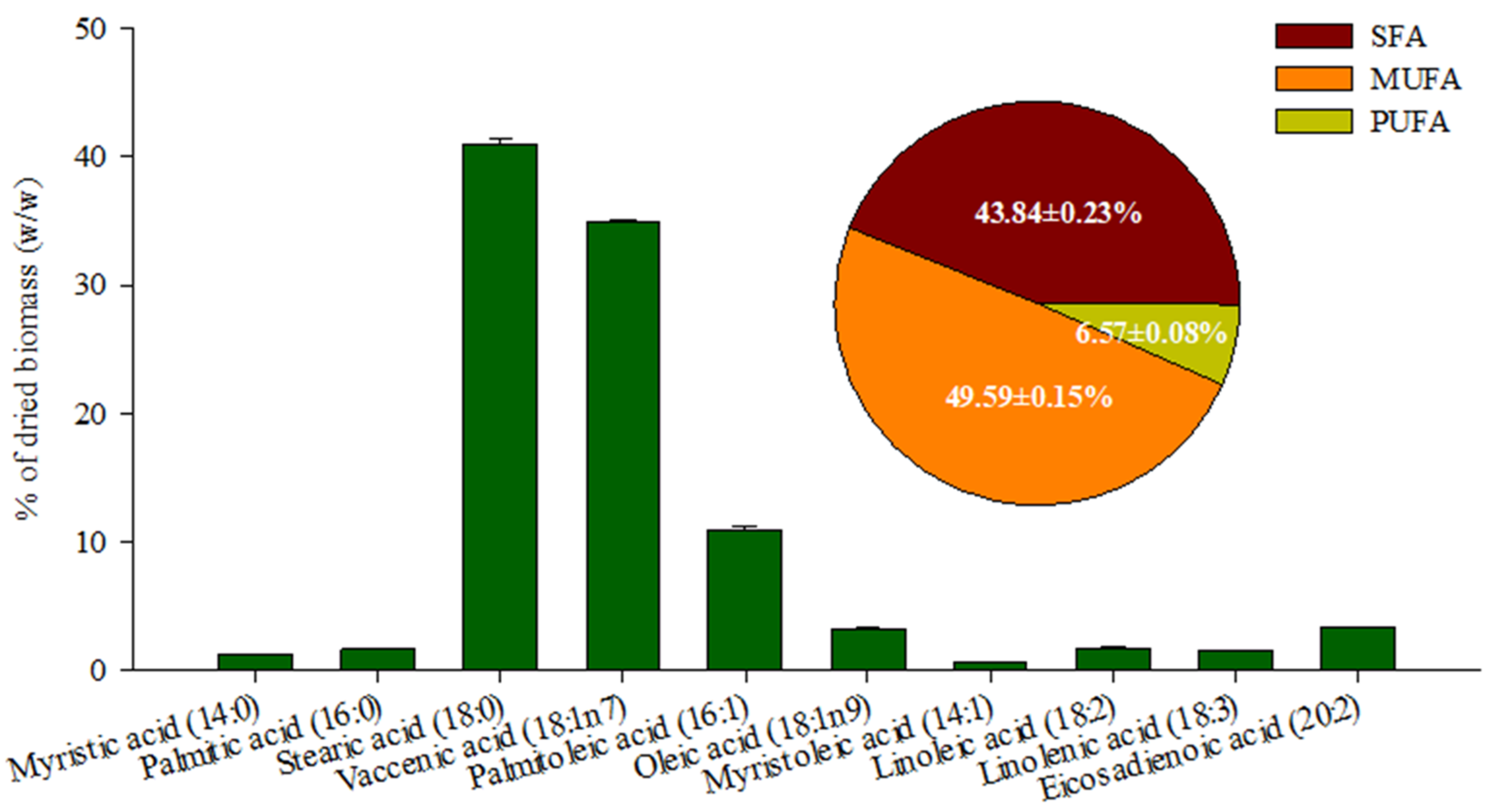Microalga Coelastrella sp. Cultivation on Unhydrolyzed Molasses-Based Medium towards the Optimization of Conditions for Growth and Biomass Production under Mixotrophic Cultivation
Abstract
:1. Introduction
2. Results and Discussion
2.1. Comparative Photoautotrophic and Mixotrophic Growth of Coelastrella sp. KKU-P1 with Different Sugars and Light Sources
2.2. Mixotrophic Cultivation of Coelastrella sp. KKU-P1 Using Molasses as a Carbon Source
2.2.1. Effect of Initial pH
2.2.2. Effect of Substrate to Inoculum (S:I) Ratio and Initial Sugar Concentration
2.2.3. Effect of Initial Nitrate Concentration
2.2.4. Effect of Light Intensity and Light/Dark Cycle
2.3. Mixotrophic Cultivation of Coelastrella sp. KKU-P1 Using Molasses and CO2 as Carbon Sources
3. Materials and Methods
3.1. Seed Microalga Preparation
3.2. Effects of Sugar Supplementation and Light Source on Mixotrophic Growth of Coelastrella sp. KKU-P1
3.3. Mixotrophic Cultivation of Coelastrella sp. KKU-P1 Using Molasses as a Carbon Source
3.4. Mixotrophic Cultivation of Coelastrella sp. KKU-P1 Using Molasses and CO2 as Carbon Sources
3.5. Analytical Methods
3.6. Statistical Analysis
4. Conclusions
Author Contributions
Funding
Institutional Review Board Statement
Informed Consent Statement
Data Availability Statement
Acknowledgments
Conflicts of Interest
Sample Availability
References
- Rizwan, M.; Mujtaba, G.; Memon, S.A.; Lee, K.; Rashid, N. Exploring the potential of microalgae for new biotechnology applications and beyond: A review. Renew. Sustain. Energy Rev. 2018, 92, 394–404. [Google Scholar] [CrossRef]
- Tang, D.Y.Y.; Khoo, K.S.; Chew, K.W.; Tao, Y.; Ho, S.H.; Show, P.L. Potential utilization of bioproducts from microalgae for the quality enhancement of natural products. Bioresour. Technol. 2020, 304, 122997. [Google Scholar] [CrossRef]
- Nayana, K.; Sudhakar, M.P.; Arunkumar, K. Biorefinery potential of Coelastrella biomass for fuel and bioproducts—A review. Biomass Convers. Biorefin. 2022, 21, 1–4. [Google Scholar] [CrossRef]
- Hu, C.W.; Chuang, L.T.; Yu, P.C.; Chen, C.N. Pigment production by a new thermotolerant microalga Coelastrella sp. F50. Food Chem. 2013, 138, 2071–2078. [Google Scholar] [CrossRef] [PubMed]
- Minhas, A.K.; Hodgson, P.; Barrow, C.J.; Sashidhar, B.; Adholeya, A. The isolation and identification of new microalgal strains producing oil and carotenoid simultaneously with biofuel potential. Bioresour. Technol. 2016, 211, 556–565. [Google Scholar] [CrossRef]
- Goecke, F.; Noda, J.; Paliocha, M.; Gislerød, H.R. Revision of Coelastrella (Scenedesmaceae, Chlorophyta) and first register of this green coccoid microalga for continental Norway. World J. Microbiol. Biotechnol. 2020, 36, 149. [Google Scholar] [CrossRef]
- Zaytseva, A.; Chekanov, K.; Zaytsev, P.; Bakhareva, D.; Gorelova, O.; Kochkin, D.; Lobakova, E. Sunscreen effect exerted by secondary carotenoids and mycosporine-like amino acids in the aeroterrestrial chlorophyte Coelastrella rubescens under high light and UV-A irradiation. Plants 2021, 10, 2601. [Google Scholar] [CrossRef] [PubMed]
- Minyuk, G.; Chelebieva, E.; Chubchikova, I.; Dantsyuk, N.; Drobetskaya, I.; Sakhon, E.; Chekanov, K.; Solovchenko, A. Stress-induced secondary carotenogenesis in Coelastrella rubescens (Scenedesmaceae, Chlorophyta), a producer of value-added keto-carotenoids. Algae 2017, 32, 245–259. [Google Scholar] [CrossRef]
- Doppler, P.; Kriechbaum, R.; Käfer, M.; Kopp, J.; Remias, D.; Spadiut, O. Coelastrella terrestris for adonixanthin production: Physiological characterization and evaluation of secondary carotenoid productivity. Mar. Drugs 2022, 26, 175. [Google Scholar] [CrossRef] [PubMed]
- Abreu, A.P.; Fernandes, B.; Vicente, A.A.; Teixeira, J.; Dragone, G. Mixotrophic cultivation of Chlorella vulgaris using industrial dairy waste as organic carbon source. Bioresour. Technol. 2012, 118, 61–66. [Google Scholar] [CrossRef] [PubMed]
- Chen, C.Y.; Yeh, K.L.; Aisyah, R.; Lee, D.J.; Chang, J.S. Cultivation, photobioreactor design and harvesting of microalgae for biodiesel production: A critical review. Bioresour. Technol. 2011, 102, 71–81. [Google Scholar] [CrossRef]
- Wang, Y.; Yu, J.; Wang, P.; Deng, S.; Chang, J.; Ran, Z. Response of energy microalgae Chlamydomonas reinhardtii to nitrogen and phosphorus stress. Environ. Sci. Pollut. Res. 2018, 25, 5762–5770. [Google Scholar] [CrossRef]
- Daneshvar, E.; Ok, Y.S.; Tavakoli, S.; Sarkar, B.; Shaheen, S.M.; Hong, H.; Luo, Y.; Rinklebe, J.; Song, H.; Bhatnagar, A. Insights into upstream processing of microalgae: A review. Bioresour. Technol. 2012, 329, 124870. [Google Scholar] [CrossRef] [PubMed]
- Aron, N.S.M.; Khoo, K.S.; Chew, K.W.; Veeramuthu, A.; Chang, J.S.; Show, P.L. Microalgae cultivation in wastewater and potential processing strategies using solvent and membrane separation technologies. J. Water Process Eng. 2021, 39, 101701. [Google Scholar] [CrossRef]
- Tedesque, M.G.; Scardoeli-Truzzi, B.; Sipaúba-Tavares, L.H. Messastrum gracile (Chlorophyceae) growth using sugarcane molasses-based macrophyte extract culture media. J. Appl. Phycol. 2021, 33, 2745–2754. [Google Scholar] [CrossRef]
- Pang, N.; Gu, X.; Chen, S.; Kirchhoff, H.; Lei, H.; Roje, S. Exploiting mixotrophy for improving productivities of biomass and co-products of microalgae. Renew. Sustain. Energy Rev. 2019, 112, 450–460. [Google Scholar] [CrossRef]
- Zhou, J.L.; Yang, L.; Huang, K.X.; Chen, D.Z.; Gao, F. Mechanisms and application of microalgae on removing emerging contaminants from wastewater: A review. Bioresour. Technol. 2022, 364, 128049. [Google Scholar] [CrossRef]
- Khanra, A.; Vasistha, S.; Kumar, S.; Rai, M.P. Cultivation of microalgae on unhydrolysed waste molasses syrup using mass cultivation strategy for improved biodiesel. 3 Biotech 2021, 11, 287. [Google Scholar] [CrossRef] [PubMed]
- Yan, D.; Lu, Y.; Chen, Y.F.; Wu, Q. Waste molasses alone displaces glucose-based medium for microalgal fermentation towards cost-saving biodiesel production. Bioresour. Technol. 2011, 102, 6487–6493. [Google Scholar] [CrossRef]
- Yew, G.Y.; Khoo, K.S.; Chia, W.Y.; Ho, Y.C.; Law, C.L.; Leong, H.Y.; Show, P.L. A novel lipids recovery strategy for biofuels generation on microalgae Chlorella cultivation with waste molasses. J. Water Process Eng. 2020, 38, 101665. [Google Scholar] [CrossRef]
- Singh, P.; Gupta, S.K.; Guldhe, A.; Rawat, I.; Bux, F. Microalgae isolation and basic culturing techniques. In Handbook of Marine Microalgae; Elsevier: Amsterdam, The Netherlands, 2015; pp. 43–54. [Google Scholar] [CrossRef]
- Procházková, G.; Brányiková, I.; Zachleder, V.; Brányik, T. Effect of nutrient supply status on biomass composition of eukaryotic green microalgae. J. Appl. Phycol. 2014, 26, 1359–1377. [Google Scholar] [CrossRef]
- Elisabeth, B.; Rayen, F.; Behnam, T. Microalgae culture quality indicators: A review. Crit. Rev. Biotechnol. 2021, 41, 457–473. [Google Scholar] [CrossRef] [PubMed]
- Ueno, Y.; Shimakawa, G.; Miyake, C.; Akimoto, S. Light harvesting strategy during CO2-dependent photosynthesis in the green alga Chlamydomonas reinhardtii. J. Phys. Chem. Lett. 2018, 9, 1028–1033. [Google Scholar] [CrossRef] [PubMed]
- Neilson, A.H.; Lewin, R.A. The uptake and utilization of organic carbon by algae: An essay in comparative biochemistry. Phycologia 1974, 13, 227–264. [Google Scholar] [CrossRef]
- Ghosh, A.; Sangtani, R.; Samadhiya, K.; Kiran, B. Maximizing intrinsic value of microalgae using multi-parameter study: Conjoint effect of organic carbon, nitrate, and phosphate supplementation. Clean Technol. Environ. Policy 2021, 25, 537–549. [Google Scholar] [CrossRef]
- Andreeva, A.; Budenkova, E.; Babich, O.; Sukhikh, S.; Dolganyuk, V.; Michaud, P.; Ivanova, S. Influence of carbohydrate additives on the growth rate of microalgae biomass with an increased carbohydrate content. Mar. Drugs 2021, 19, 381. [Google Scholar] [CrossRef]
- Yee, W. Feasibility of various carbon sources and plant materials in enhancing the growth and biomass productivity of the freshwater microalgae Monoraphidium griffithii NS16. Bioresour. Technol. 2015, 196, 1–8. [Google Scholar] [CrossRef]
- Bajwa, K.; Bishnoi, N.R.; Kirrollia, A.; Selvan, S.T. A new lipid rich microalgal SP Scenedesmus dimorphus isolated: Nile red staining and effect of carbon, nitrogen sources on its physio-biochemical components. Eur. J. Sustain. Dev. 2018, 2, 43. [Google Scholar] [CrossRef]
- Du, F.; Hu, C.; Sun, X.; Xu, N. Transcriptome analysis reveals pathways responsible for the promoting effect of sucrose on astaxanthin accumulation in Haematococcus pluvialis under high light condition. Aquaculture 2021, 530, 735757. [Google Scholar] [CrossRef]
- Rajivgandhi, G.; Ramachandran, G.; Chelliah, C.K.; Maruthupandy, M.; Quero, F.S.V.; Vijayalakshmif, S.; AL-Mekhlafi, F.A.; Wadaan, M.A.; Ranjitha, J.; Li, W.J. Green microalgal strain Chlorella vulgaris isolated from industrial wastewater with remediation capacity. Environ. Technol. Inno. 2022, 28, 102597. [Google Scholar] [CrossRef]
- Girard, J.M.; Roy, M.L.; Hafsa, M.B.; Gagnon, J.; Faucheux, N.; Heitz, M.; Tremblay, R.; Deschênes, J.S. Mixotrophic cultivation of green microalgae Scenedesmus obliquus on cheese whey permeate for biodiesel production. Algal Res. 2014, 5, 241–248. [Google Scholar] [CrossRef]
- Freitas, B.C.B.; Brächer, E.H.; de Morais, E.G.; Atala, D.I.P.; de Morais, M.G.; Costa, J.A.V. Cultivation of different microalgae with pentose as carbon source and the effects on the carbohydrate content. Environ. Technol. 2019, 40, 1062–1070. [Google Scholar] [CrossRef]
- Freitas, B.C.B.; Morais, M.G.; Costa, J.A.V. Chlorella minutissima grown with xylose and arabinose in tubular photobioreactors: Evaluation of kinetics, carbohydrate production, and protein profile. Can. J. Chem. Eng. 2022, 100, S49–S57. [Google Scholar] [CrossRef]
- Hassall, K.A. Xylose as a specific inhibitor of photosynthesis. Nature 1958, 181, 1273–1274. [Google Scholar] [CrossRef]
- Lehmuskero, A.; Chauton, M.S.; Boström, T. Light and photosynthetic microalgae: A review of cellular- and molecular-scale optical processes. Prog. Oceanogr. 2018, 168, 43–56. [Google Scholar] [CrossRef]
- Schulze, P.S.; Barreira, L.A.; Pereira, H.G.; Perales, J.A.; Varela, J.C. Light emitting diodes (LEDs) applied to microalgal production. Trends Biotechnol. 2014, 32, 422–430. [Google Scholar] [CrossRef] [PubMed]
- Yadav, N.; Singh, D.P. Photosynthetic efficiency and compositional alterations in microalgae Chlorella vulgaris in response to changes in the pH condition. Vegetos 2021, 34, 119–126. [Google Scholar] [CrossRef]
- Reyimu, Z.; Özçimen, D. Batch cultivation of marine microalgae Nannochloropsis oculata and Tetraselmis suecica in treated municipal wastewater toward bioethanol production. J. Clean. Prod. 2017, 150, 40–46. [Google Scholar] [CrossRef]
- Li, Z.; Haifeng, L.; Zhang, Y.; Shanshan, M.; Baoming, L.; Zhidan, L.; Na, D.; Minsheng, L.; Buchun, S.; Jianwan, L. Effects of strain, nutrients concentration and inoculum size on microalgae culture for bioenergy from post hydrothermal liquefaction wastewater. Int. J. Agric. Biol. Eng. 2017, 10, 194–204. [Google Scholar] [CrossRef]
- Huang, Y.; Luo, L.; Xu, K.; Wang, X.C. Characteristics of external carbon uptake by microalgae growth and associated effects on algal biomass composition. Bioresour. Technol. 2019, 292, 121887. [Google Scholar] [CrossRef]
- El-Sheekh, M.; Abomohra, A.E.F.; Hanelt, D. Optimization of biomass and fatty acid productivity of Scenedesmus obliquus as a promising microalga for biodiesel production. World J. Microbiol. Biotechnol. 2013, 29, 915–922. [Google Scholar] [CrossRef]
- El-Sheekh, M.W.; El-Mohsnawy, E.; Mabrouk, M.E.M.; Zoheir, W.F. Enhancement of biodiesel production from the green microalga Micractinium reisseri via optimization of cultivation regimes. J. Taibah. Univ. Sci. 2020, 14, 437–444. [Google Scholar] [CrossRef]
- Borsari, R.R.J.; Morioka, L.R.I.; Ribeiro, M.L.L.; Buzato, J.B.; Pinotti, M.H.P. Mixotrophic growth of Nostoc sp. on glucose, sucrose and sugarcane molasses for phycobiliprotein production. Acta Sci. Biol. Sci. 2007, 29, 9–13. [Google Scholar] [CrossRef]
- Manzoor, M.; Ahmad, Q.U.A.; Aslam, A.; Jabeen, F.; Rasul, A.; Schenk, P.M.; Qazi, J.I. Mixotrophic cultivation of Scenedesmus dimorphus in sugarcane bagasse hydrolysate. Environ. Prog. Sustain. Energy 2020, 39, e13334. [Google Scholar] [CrossRef]
- Yin, F.W.; Zhu, S.Y.; Guo, D.S.; Ren, L.J.; Ji, X.J.; Huang, H.; Gao, Z. Development of a strategy for the production of docosahexaenoic acid by Schizochytrium sp. from cane molasses and algae-residue. Bioresour. Technol. 2019, 271, 118–124. [Google Scholar] [CrossRef]
- Ranadheer, P.; Kona, R.; Sreeharsha, R.V.; Mohan, S.V. Non-lethal nitrate supplementation enhances photosystem II efficiency in mixotrophic microalgae towards the synthesis of proteins and lipids. Bioresour. Technol. 2019, 283, 373–377. [Google Scholar] [CrossRef]
- Khanra, A.; Vasistha, S.; Kumar, P.; Rai, M.P. Role of C/N ratio on microalgae growth in mixotrophy and incorporation of titanium nanoparticles for cell flocculation and lipid enhancement in economical biodiesel application. 3 Biotech 2020, 10, 331. [Google Scholar] [CrossRef] [PubMed]
- Zalogin, T.R.; Pick, U. Inhibition of nitrate reductase by azide in microalgae results in triglycerides accumulation. Algal Res. 2014, 3, 17–23. [Google Scholar] [CrossRef]
- Zhu, L.; Li, S.; Hu, T.; Nugroho, Y.K.; Yin, Z.; Hu, D.; Chu, R.; Mo, F.; Liu, C.; Hiltunen, E. Effects of nitrogen source heterogeneity on nutrient removal and biodiesel production of mono- and mix-cultured microalgae. Energy Convers. Manag. 2019, 201, 112144. [Google Scholar] [CrossRef]
- Deng, X.; Chen, K.; Xue, C.; Li, D.; Hu, X.; Gao, K. Biomass production and biochemical profiles of a freshwater microalga Chlorella kessleri in mixotrophic culture: Effects of light intensity and photoperiodicity. Bioresour. Technol. 2019, 273, 358–367. [Google Scholar] [CrossRef]
- Patel, A.K.; Joun, J.M.; Hong, M.E.; Sim, S.J. Effect of light conditions on mixotrophic cultivation of green microalgae. Bioresour. Technol. 2019, 282, 245–253. [Google Scholar] [CrossRef] [PubMed]
- Corato, A.; Le, T.T.; Baurain, D.; Jacques, P.; Remacle, C.; Franck, F. A fast-growing oleaginous strain of Coelastrella capable of astaxanthin and canthaxanthin accumulation in phototrophy and heterotrophy. Life 2022, 12, 334. [Google Scholar] [CrossRef]
- Narayanan, G.S.; Seepana, S.; Elankovan, R.; Arumugan, S.; Premalatha, M. Isolation, identification and outdoor cultivation of thermophilic freshwater microalgae Coelastrella sp. FI69 in bubble column reactor for the application of biofuel production. Biocatal. Agric. Biotechnol. 2018, 14, 357–365. [Google Scholar] [CrossRef]
- Sforza, E.; Cipriani, R.; Morosinotto, T.; Bertucco, A.; Giacometti, G.M. Excess CO2 supply inhibits mixotrophic growth of Chlorella protothecoides and Nannochloropsis salina. Bioresour. Technol. 2012, 104, 523–529. [Google Scholar] [CrossRef] [PubMed]
- Aratboni, H.A.; Rafiei, N.; Garcia-Granados, R.; Alemzadeh, A.; Morones-Ramírez, J.R. Biomass and lipid induction strategies in microalgae for biofuel production and other applications. Microb. Cell Factories 2019, 18, 187. [Google Scholar] [CrossRef]
- Jensen, R.G.; Bahr, J.T. Ribilose1,5-bisphosphate carboxylase-oxygenase. Annu. Rev. Plant Physiol. 1977, 28, 379–400. [Google Scholar] [CrossRef]
- Pham, K.T.; Nguyen, T.C.; Luong, T.H.; Dang, P.H.; Vu, D.C.; Do, T.N.; Phi, T.C.M.; Nguyen, D.B. Influence of inoculum size, CO2 concentration and LEDs on the growth of green microalgae Haematococcus pluvialis Flotow. Vietnam J. Sci. Technoland Eng. 2018, 60, 59–65. [Google Scholar] [CrossRef]
- Jain, D.; Ghonse, S.S.; Trivedi, T.; Fernandes, G.L.; Menezes, L.D.; Damare, S.R.; Mamatha, S.S.; Kumar, S.; Gupta, V. CO2 fixation and production of biodiesel by Chlorella vulgaris NIOCCV under mixotrophic cultivation. Bioresour. Technol. 2019, 273, 672–676. [Google Scholar] [CrossRef]
- Izumo, A.; Fujiwara, S.; Oyama, Y.; Satoh, A.; Fujita, N.; Nakamura, Y.; Tsuzuki, M. Physicochemical properties of starch in Chlorella change depending on the CO2 concentration during growth: Comparison of structure and properties of pyrenoid and stroma starch. Plant Sci. 2007, 172, 1138–1147. [Google Scholar] [CrossRef]
- Hartmann, A.; Albert, A.; Ganzera, M. Effects of elevated ultraviolet radiation on primary metabolites in selected alpine algae and cyanobacteria. J. Photochem. Photobiol. B Biol. 2015, 149, 149–155. [Google Scholar] [CrossRef]
- Sousa, V.; Loureiro, L.; Carvalho, G.; Pereira, R.N. Extraction of biomolecules from Coelastrella sp. LRF1 biomass using Ohmic Heating technology. Innov. Food Sci. Emerg. Technol. 2022, 80, 103059. [Google Scholar] [CrossRef]
- Brown, M.R. The amino-acid and sugar composition of 16 species of microalgae used in mariculture. J. Exp. Mar. Bilogy Ecol. 1991, 145, 79–99. [Google Scholar] [CrossRef]
- Castillo, S.; Gatlin, D.M. Dietary requirements for leucine, isoleucine and valine (branched-chain amino acids) by juvenile red drum Sciaenops ocellatus. Aquac. Nutr. 2018, 24, 1056–1065. [Google Scholar] [CrossRef]
- Takagi, S.Y.; Murata, S.; Koshiishi, T.; Agatsuma, Y. The amino acids glutamic acid and alanine in feed increase the alanine content in gonads of the sea urchin Mesocentrotus nudus. Front. Mar. Sci. 2020, 7, 593. [Google Scholar] [CrossRef]
- Li, P.; Wu, G. Roles of dietary glycine, proline, and hydroxyproline in collagen synthesis and animal growth. Amino Acids. 2018, 50, 29–38. [Google Scholar] [CrossRef]
- Gong, Q.; Yang, D.; Jiang, M.; Zheng, J.; Peng, B. l-aspartic acid promotes fish survival against Vibrio alginolyticus infection through nitric oxide-induced phagocytosis. Fish Shellfish Immunol. 2020, 97, 359–366. [Google Scholar] [CrossRef] [PubMed]
- Minyuk, G.S.; Chelebieva, E.S.; Chubchikova, I.N.; Dantsyuk, N.V.; Drobetskaya, I.V.; Sakhon, E.G.; Chivkunova, O.B.; Chekanov, K.A.; Lobakova, E.S.; Sidorov, R.A.; et al. pH and CO2 effects on Coelastrella (Scotiellopsis) rubescens growth and metabolism. Russ. J. Plant Physiol. 2016, 63, 566–574. [Google Scholar]
- Lee, S.A.; Ko, S.R.; Lee, N.; Lee, J.W.; Van Le, V.; Oh, H.M.; Ahn, C.Y. Two-step microalgal (Coelastrella sp.) treatment of raw piggery wastewater resulting in higher lipid and triacylglycerol levels for possible production of higher-quality biodiesel. Bioresour. Technol. 2021, 332, 125081. [Google Scholar] [CrossRef]
- Karpagam, R.; Raj, K.J.; Ashokkumar, B.; Varalakshmi, P. Characterization and fatty acid profiling in two fresh water microalgae for biodiesel production: Lipid enhancement methods and media optimization using response surface methodology. Bioresour. Technol. 2015, 188, 177–184. [Google Scholar] [CrossRef]
- Boutarfa, S.; Senoussi, M.M.; Gonzalez-Silvera, D.; López-Jiménez, J.Á.; Aboal, M. The Green Microalga Coelastrella thermophila var. globulina (Scenedesmaceae, Chlorophyta) isolated from an Algerian hot spring as a potential source of fatty acids. Life 2022, 12, 560. [Google Scholar] [CrossRef]
- Bischoff, H.W.; Bold, H.C. Some algae from enchanted rock and related algal species. In Phycological Studies IV; Univiversity of Texas Publications: Austin, TX, USA, 1963; pp. 1–95. [Google Scholar]
- Albuquerque, M.G.; Eiroa, M.; Torres, C.; Nunes, B.R.; Reis, M.A. Strategies for the development of a side stream process for polyhydroxyalkanoate (PHA) production from sugar cane molasses. J. Biotechnol. 2007, 130, 411–421. [Google Scholar] [CrossRef] [PubMed]
- Gasmalla, M.A.; Yang, R.; Nikoo, M.; Man, S. Production of ethanol from Sudanese sugar cane molasses and evaluation of its quality. J. Food Process Technol. 2012, 3, 163–165. [Google Scholar] [CrossRef]
- Palmonari, A.; Cavallini, D.; Sniffen, C.J.; Fernandes, L.; Holder, P.; Fagioli, L.; Fusaro, I.; Biagi, G.; Formigoni, A.; Mammi, L. Characterization of molasses chemical composition. J. Dairy Sci. 2020, 103, 6244–6249. [Google Scholar] [CrossRef] [PubMed]
- Dubois, M.; Gilles, K.A.; Hamilton, J.K.; Rebers, P.T.; Smith, F. Colorimetric method for determination of sugars and related substances. Anal. Chem. 1956, 28, 350–356. [Google Scholar] [CrossRef]
- American Public Health Association (APHA). Standard Methods for the Examination of Water and Wastewater, 20th ed.; Water Environment Federation: Washington, DC, USA, 1999. [Google Scholar]
- Pruvost, J.; Van Vooren, G.; Le Gouic, B.; Couzinet-Mossion, A.; Legrand, J. Systematic investigation of biomass and lipid productivity by microalgae in photobioreactors for biodiesel application. Bioresour. Technol. 2011, 102, 150–158. [Google Scholar] [CrossRef]
- Mishra, S.K.; Suh, W.I.; Farooq, W.; Moon, M.; Shrivastav, A.; Park, M.S.; Yang, J.W. Rapid quantification of microalgal lipids in aqueous medium by a simple colorimetric method. Bioresour. Technol. 2014, 155, 330–333. [Google Scholar] [CrossRef]
- Byreddy, A.R.; Gupta, A.; Barrow, C.J.; Puri, M. Comparison of cell disruption methods for improving lipid extraction from thraustochytrid strains. Mar. Drugs 2015, 13, 5111–5127. [Google Scholar] [CrossRef]
- Huang, T.Y.; Lu, W.C.; Chu, I.M. A fermentation strategy for producing docosahexaenoic acid in Aurantiochytrium limacinum SR21 and increasing C22:6 proportions in total fatty acid. Bioresour. Technol. 2012, 123, 8–14. [Google Scholar] [CrossRef]
- Singh, D.P.; Khatta, K.S.; Rajput, A.; Chaudhary, R.; Singh, R. High production of carotenoids by the green microalga Asterarcys quadricellulare PUMCC 5.1.1 under optimized culture conditions. PLoS ONE 2019, 14, e0221930. [Google Scholar] [CrossRef]







| Essential Amino Acids (EAA) | nmol/mg | Non-Essential Amino Acids (NEAA) | nmol/mg |
|---|---|---|---|
| Threonine | 68.74 ± 9.17 | Aspartic acid | 126.96 ± 16.94 |
| Valine | 109.64 ± 14.63 | Serine | 75.94 ± 10.13 |
| Methionine | 26.38 ± 3.52 | Glutamic acid | 157.16 ± 20.97 |
| Isoleucine | 50.50 ± 6.74 | Proline | 53.30 ± 7.11 |
| Leucine | 126.00 ± 16.81 | Glycine | 150.44 ± 20.08 |
| Phenylalanine | 60.92 ± 8.13 | Alanine | 196.86 ± 26.27 |
| Histidine | 24.40 ± 3.26 | Cysteine | 3.18 ± 0.42 |
| Lysine | 62.20 ± 8.30 | Tyrosine | 26.50 ± 3.54 |
| Arginine | 64.90 ± 8.66 | ||
| Tryptophan | Not detected |
Disclaimer/Publisher’s Note: The statements, opinions and data contained in all publications are solely those of the individual author(s) and contributor(s) and not of MDPI and/or the editor(s). MDPI and/or the editor(s) disclaim responsibility for any injury to people or property resulting from any ideas, methods, instructions or products referred to in the content. |
© 2023 by the authors. Licensee MDPI, Basel, Switzerland. This article is an open access article distributed under the terms and conditions of the Creative Commons Attribution (CC BY) license (https://creativecommons.org/licenses/by/4.0/).
Share and Cite
Thepsuthammarat, K.; Reungsang, A.; Plangklang, P. Microalga Coelastrella sp. Cultivation on Unhydrolyzed Molasses-Based Medium towards the Optimization of Conditions for Growth and Biomass Production under Mixotrophic Cultivation. Molecules 2023, 28, 3603. https://doi.org/10.3390/molecules28083603
Thepsuthammarat K, Reungsang A, Plangklang P. Microalga Coelastrella sp. Cultivation on Unhydrolyzed Molasses-Based Medium towards the Optimization of Conditions for Growth and Biomass Production under Mixotrophic Cultivation. Molecules. 2023; 28(8):3603. https://doi.org/10.3390/molecules28083603
Chicago/Turabian StyleThepsuthammarat, Kamolwan, Alissara Reungsang, and Pensri Plangklang. 2023. "Microalga Coelastrella sp. Cultivation on Unhydrolyzed Molasses-Based Medium towards the Optimization of Conditions for Growth and Biomass Production under Mixotrophic Cultivation" Molecules 28, no. 8: 3603. https://doi.org/10.3390/molecules28083603






